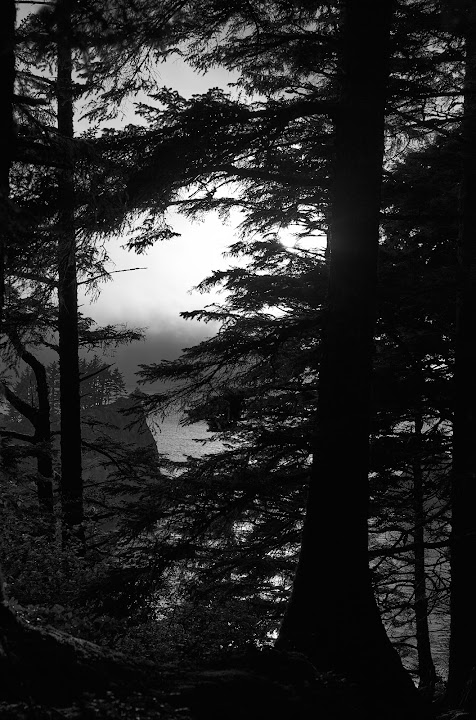In September my son and I conducted another in our continuing series of photo safaris, this time to Washington's Olympic National Park. It was a wonderful trip that burned through a lot of batteries. From stunning Pacific Ocean views to incredible mountain views, Washington's Olympic Peninsula has it all. We were in the area for a week and based out of two different locations.
First was Forks, WA which was perfectly suited for close proximity to the Pacific Ocean beaches which are a part of the park, as well as to the fantastical Hoh Rain Forest on the west side of the park proper. While there are several beach areas associated with the park, we found Ruby Beach to be the most photogenic. A rugged coastline with enormous washed up tree trunks along the rocky beach. We made several trips to Ruby Beach to cover sunsets and sunrises. Beautiful and highly recommended. And what is there is say about the Hoh Rainforest that hasn't already been said? It is an incredible location with spectacular hiking trails through what appears to be a primordial landscape. Simply amazing.
The second home base was at Port Angeles, WA. This location provides access into the north entrance of the park and is very convenient to the Hurricane Ridge area with its many amazing views and hiking trails. And as with the Forks portion of the visit, we were up early for sunrise lighting and stayed late for those stunning sunsets. Additionally, the small city of Port Angeles is very charming and hosts. a number of pubs, restaurants and shopping catering to the adventure tourists traveling in from Seattle or Vancouver (British Columbia, just to the north across the Straits of Juan de Fuca). We stayed at a charming little Vrbo just a few minutes walk from the downtown area. Again highly recommended.
In between the two areas we visited Cape Flattery. This is located on the northwestern most corner of the continental United States. Just off the coastline proper is an island, Tatoosh Island, hosting a light house. That light, in addition to marking the dangers of the rocky coastline, also marks the entrance into the Straits of Juan de Fuca (https://en.wikipedia.org/wiki/Cape_Flattery_Light). That Strait is the dividing line between the U.S. and Canada. In fact Victoria, BC is just a one hour ferry ride due north out of Port Angeles. The Straits are one of the most heavily trafficked waterways in our country and it is "controlled" by a Vessel Traffic System managed by the U.S. Coast Guard at the Port of Seattle. In my past professional life I traveled that Strait many times on board a vessel which was 600 feet long and that displaced 20,000 tons. I remember most the fog and the "loggerheads" (large tree trunks bobbing vertically in the water with just a few feet showing above the surface of the water). Good times. Anyway, there is a small parking lot at the trailhead which leads to the high promontory point overlooking Tatoosh Island. This is a rugged and beautiful landscape. BTW, the land is part of the Makah tribal area and you will need (or at least should have) a recreation pass to park and hike to the point. We bought ours (don't remember the cost but it was minimal) in the small town of Neah Bay on the drive to Cape Flattery.
For this trip I brought along what has become my standard camera kit. Leica M10R with three prime lenses - Zeiss 25mm f/2.8 Biogon, Voigtlander 50mm f/1.5 Nokton and the Voigtlander 90mm f/2.8 APO Skopar. Additionally, I brought along a Leica M3 and a handful of 35mm color film. As noted in previous posts, I love the interchangeability of lenses between the film camera made in 1958 and the digital camera made in 2021. That said, I shot the M10R almost exclusively and, sadly, as of this post the only roll of film I shot has yet to be developed. I ended up shooting the 25mm a lot in the towns and the 90mm a lot for the landscapes. In between was the 50mm. This coming March 2024 we are going to Iceland for a two week photo tour of the Ring Road and I am planning this same kit.
Different this trip was that I did not bring along my laptop to upload and process images each evening. Instead, I brought along an iPad loaded with an iOS app named Darkroom. While not as full featured as my usual Capture One, it is quite powerful and I produced images of which I am very pleased. After each days shooting I would connect the M10R to the iPad via Leica's always reliable Fotos app, upload a few of my favorite images, process those with Darkroom, then save the resulting into my Apple Photos library. That location provides instant access to text / email images to where ever or to upload to Instagram. Prior to the trip I was concerned about the lack of laptop and lack of ability to backup images to the cloud. However, in the end I decided to swap out SD cards on a daily basis. Not a 100% safety factor as I still had the cards on my person (or in the room or car) but at least I didn't feel I needed to worry about card failure in the camera ruining previous images. And as I have come to realize that even with the M10R's 40mp sensor, 32GB SD cards are plenty big enough and, in the wider world of all things related to digital camera, very cheap. I brought along a card for each day's use and the system worked a charm. I'll probably do the same for Iceland.
It was another wonderful photo safari with my son and we're looking forward to many more to come. See below a few of my favorite images.
Cape Flattery




